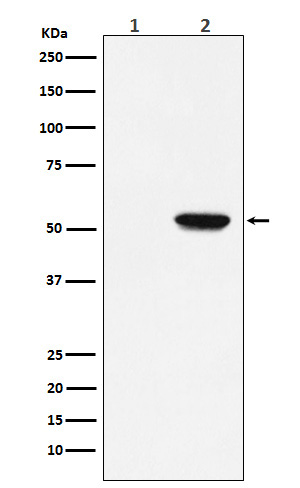

| WB | 咨询技术 | Human,Mouse,Rat |
| IF | 咨询技术 | Human,Mouse,Rat |
| IHC | 1/100-1/200 | Human,Mouse,Rat |
| ICC | 技术咨询 | Human,Mouse,Rat |
| FCM | 咨询技术 | Human,Mouse,Rat |
| Elisa | 咨询技术 | Human,Mouse,Rat |
| Aliases | hMLKL; Mlkl;;p-MLKL (S358) |
| WB Predicted band size | 54 kDa |
| Host/Isotype | Rabbit IgG |
| Antibody Type | Primary antibody |
| Storage | Store at 4°C short term. Aliquot and store at -20°C long term. Avoid freeze/thaw cycles. |
| Species Reactivity | Human |
| Immunogen | A synthesized peptide derived from human MLKL around the phosphorylation site of S358 |
| Formulation | Purified antibody in PBS with 0.05% sodium azide,0.05% BSA and 50% glycerol. |
+ +
以下是3篇涉及Phospho-MLKL(S358)抗体的关键文献摘要:
1. **文献名称**:*MLKL post-translational modifications: dynamic switches of necroptotic death signaling*
**作者**:Samson AL et al.
**摘要**:该研究系统分析了MLKL蛋白的翻译后修饰,证实S358位点的磷酸化是坏死性凋亡(necroptosis)激活的关键标志。作者利用Phospho-MLKL(S358)抗体在小鼠模型中验证了该位点磷酸化与炎症性肠病的关系。
2. **文献名称**:*Structural insight into MLKL recognition by RIPK3 in necroptosis*
**作者**:Xie T et al.
**摘要**:通过结构生物学手段解析RIPK3激酶对MLKL的磷酸化机制,研究使用Phospho-MLKL(S358)抗体证实了S358磷酸化导致MLKL构象变化,进而引发细胞膜透化及细胞死亡。
3. **文献名称**:*A fluorescent reporter mouse for necroptosis reveals cell death dynamics in vivo*
**作者**:Newton K et al.
**摘要**:开发了一种基于Phospho-MLKL(S358)抗体检测的荧光报告小鼠模型,实时追踪体内坏死性凋亡活动,揭示其在败血症和缺血再灌注损伤中的动态调控机制。
4. **文献名称**:*RIPK3 activates parallel pathways of MLKL-driven necroptosis and FADD-mediated apoptosis*
**作者**:Mandal P et al.
**摘要**:研究揭示RIPK3通过磷酸化MLKL(S358)诱导坏死性凋亡,同时调控FADD依赖性凋亡。使用该抗体区分了两种死亡途径在病毒感染模型中的不同贡献。
---
这些研究均通过Phospho-MLKL(S358)抗体验证了坏死性凋亡的激活机制及病理意义,涵盖结构生物学、疾病模型和体内动态追踪等多方面。
The Phospho-MLKL(S358) antibody is a specialized tool used to detect phosphorylation of the mixed lineage kinase domain-like (MLKL) protein at serine 358 (S358), a critical post-translational modification in necroptosis—a form of programmed necrotic cell death. MLKL acts as the terminal executor of necroptosis, transitioning from an inert state to an active oligomerized form upon phosphorylation by receptor-interacting protein kinase 3 (RIPK3). This phosphorylation event, particularly at S358 (human; equivalent to murine S345), triggers MLKL's conformational change, enabling its translocation to the plasma membrane to induce membrane permeabilization and cell death.
The antibody is widely employed in research to study necroptotic signaling in physiological and pathological contexts, including inflammatory diseases, neurodegenerative disorders, and cancer. By specifically recognizing phosphorylated S358. it allows detection of activated MLKL via techniques like Western blotting, immunofluorescence, or immunohistochemistry. Validating its specificity is crucial, often achieved using MLKL-knockout cell lines or RIPK3/MLKL inhibitors to confirm signal dependency. Researchers rely on this tool to dissect regulatory mechanisms, screen therapeutic agents targeting necroptosis, or explore disease models where dysregulated cell death pathways contribute to pathogenesis. Its application bridges mechanistic insights into cell death control and potential clinical interventions.
×